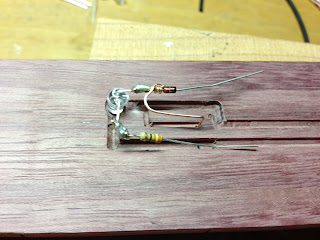Used some epoxy to fill in the hole where the wires come out.
Looks pretty good. The wires are a very small diameter (26 gauge) but they are stranded, so they are pretty resilient if bent repeatedly.
All of my fret wire supplies. The fret wire comes in a tube like the one in the middle. It is straight. I made my own fret wire radius bending tool (on the top left). I modified some nippers by grinding them flush (to make flush-cut snippers). I also have a plastic dead-blow hammer, which is filled with buckshot so it doesn't bounce when you hammer something.
I used this nail file to pop the copper wires back up out of the slots.
You can see that one of the copper wires broke from being bent too many times.
A second copper wire also broke off. I was a little worried that it wouldn't make as good a connection with the fret wire when the fret wire gets pounded in, but I tested it once it was done, and it works just fine.
I like to bend my copper wires off to the side and then pound the wire in over it.
Before and after pounding the fret wire. Just snip off the copper wire when you are done.
Now it REALLY is starting to look like a guitar neck. I filed and sanded the ends of the fret wire until the corners were nice and rounded. I ran my fingers up and down the fretboard to see if the fret wire snags on my fingers or if it is smooth. I think I got this fretboard smoother than the stock one from the factory!
Next, I need to level the frets and use fret files to crown and smooth them again. This is usually necessary if you don't want your guitar to "buzz" when you play. Otherwise you have to raise the action of your guitar uncomfortably high to avoid "buzzing" strings on the frets. I would say that most guitars you buy at the store have not leveled and crowned the frets. That's why so many guitarists have guitars with really high action, and it hurts their hands to play. Take your new guitar to a luthier to get the frets leveled and your action adjusted. It will make playing guitar much more enjoyable.











































































